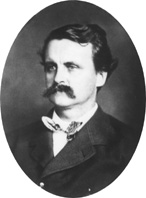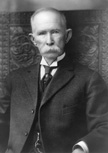Looking back in Virginia Tech's 125th year: The Rocky Beginning
by Clara B. Cox
The Birth
If Virginia Tech's founding fathers were alive to celebrate its 125th anniversary this year, they would surely sigh with relief. In fact, most would be amazed that the school survived its early years to become the commonwealth's largest, most diverse university. Even by mountaineers' standards back then, the first decade and a half at Virginia's land-grant university were rocky.
With established colleges and universities such as William and Mary, Virginia Military Institute, and the University of Virginia pressing claims for Virginia's land-grant monies after the Civil War, it seems astonishing that the small, young Preston and Olin Institute, a financially strapped, Methodist "seminary of learning" in Blacksburg, entered the fray. Two representatives of the school--the former president Rev. Peter Harrison Whisner and trustee Dr. Harvey Black--promised that the citizens of Montgomery County would contribute $20,000 for new buildings should their petition succeed in the General Assembly.
Perhaps tired of the heated controversy and looking for the best solution among the 24 contenders for the land-grant funds, the legislature approved the bill supporting Preston and Olin Institute on March 13 and 14, 1872. Gov. Gilbert Walker signed the bill into law on March 19, 1872, creating the Virginia Agricultural and Mechanical College (VAMC), the commonwealth's first land-grant institution.
Born in battle, VAMC should have been armed for the years that followed.
The Minor Years
A single vote reportedly separated Charles Landon Carter Minor, former president of the Maryland Agricultural College, from his closest rival for the presidency of VAMC. With that one vote, Minor, who was teaching at Sewanee Episcopal Seminary in Tennessee, became the new school's first president in 1872. His seven years at the helm of the college would not always be smooth as he gained the dubious reputation of being the only president known to trade punches with a professor.
With his three faculty members--none a professor of agriculture or mechanics--and school treasurer, the president opened the doors to VAMC on Oct. 1, 1872, to interested males. By the time 16-year-old William Addison "Add" Caldwell wandered in after walking from his home in Craig County, the group reportedly was so happy to finally have a student that they awarded the farmboy a scholarship.
 Only 29 students had enrolled in the first week. Minor was convinced that a statement issued by William Ruffner, Virginia's first state superintendent of public instruction, deterred prospective students. Ruffner, who had called VAMC "a truly technical school of secondary grade," created the impression, Minor believed, that VAMC would be a technical high school rather than a college.
Only 29 students had enrolled in the first week. Minor was convinced that a statement issued by William Ruffner, Virginia's first state superintendent of public instruction, deterred prospective students. Ruffner, who had called VAMC "a truly technical school of secondary grade," created the impression, Minor believed, that VAMC would be a technical high school rather than a college.
Ruffner's description was dropped from all reports, the program was changed, and Minor advertised in newspapers statewide. By year's end, the enrollment of 132 exceeded expectations, causing Minor to complain that the school's one building--the Preston and Olin Building--was inadequate. At his request, the General Assembly in 1874 appropriated $45,000 to construct more buildings.
During Minor's term, donations of livestock, machinery, seeds, and tools helped equip the college farm as a training ground for students. A library was started, although the 501 books donated the first year were mostly dust collectors. Commencement activities were begun for students receiving certificates--not degrees--for completing their three-year programs.
Most of the students lived in town, and complaints poured into the college about their behavior. Gen. James H. Lane, the professor of mathematics and foreign languages with responsibility for military training, proposed that the college be organized along military lines to keep students under constant supervision. Minor believed the required military drill was sufficient.
Two factions developed, and the situation deteriorated. Lane accused Minor in a faculty meeting of setting himself up as "the great I am of the college." Minor postponed the meeting, but the verbal battle resumed when the group reconvened two days later. Lane, apparently feeling that his veracity had been questioned by the president, advanced toward Minor, who was reportedly an excellent boxer, shaking his fist. The generally easygoing Minor struck Lane, and the two men got into a fistfight. They were charged and convicted of disorderly conduct, eroding confidence in the Minor administration and causing a decline in enrollment. Ultimately, Minor was removed from office, albeit amid howls of protest throughout the state when a pro-military faction took over the board of visitors.
The Buchanan Months
"In, out, in, out" could best describe the VAMC presidency--or presidencies--of John Lee Buchanan, a native Southwest Virginian and former president of Emory and Henry College. He was offered the VAMC presidency after the board of visitors removed Minor from the post.
Buchanan took over March 1, 1880, under new directives from the board of visitors granting his office additional administrative authority. But the turmoil that began under his predecessor continued, with one researcher even suggesting that the college be turned into an asylum.
Montgomery County's state senator, J.E. Eskridge, initiated a movement in the General Assembly to have the college's affairs investigated, and the brouhaha that resulted focused attention on the political control of the school rather than on the education it offered. Buchanan scarcely warmed his chair before the legislature removed the board of visitors, effective June 4, and directed a new board to remove all faculty and administration. The clean sweep was effective on June 12.
The Shipp Days
Offered the job as president once again by the new board, Buchanan refused, and Lt. Col. Scott Shipp (he added the second p to his name around 1883), commandant of cadets and professor of military tactics at Virginia Military Institute (VMI), was elected to the position and designated professor of mental and moral philosophy. A graduate of VMI and Washington College (now Washington and Lee University), he had led the VMI cadets in the Battle of New Market during the Civil War.
Shipp accepted the offer. But when he realized during his first meeting with the executive committee that the board, and not the new faculty, would handle details of the college's organization, he immediately resigned. His "tenure" as the third president had lasted less than two weeks, Aug. 12-25, 1880; reports differ on whether he spent four days or one day on campus.
Buchanan's Second Term

The VAMC presidency was then offered, unsuccessfully, to Ruffner. The reluctant professor John Hart was named acting president. Hart directed VAMC for the entire session of 1880-81, a bleak time when funds were scarce and all the controversy surrounding the school had dramatically reduced enrollment--a record low of 50 students had attended the previous year. Twice that fall, the board of visitors offered the presidency to Ruffner, who again declined.
In a May 1881 meeting, the board turned once more to Buchanan. Apparently convinced that the operation of the college would be left to him and that the General Assembly would now leave VAMC alone, he accepted the offer and re-assumed the presidency on Aug. 14, 1881. But Buchanan was to have a deja vu experience.
When a new governor learned that the state senate had not approved the board of visitors, as required by the resolution the previous year, he nominated a new board, which was confirmed on Jan. 17, 1882. In a meeting the same day, the board removed the president, professors, and other officers and filled the vacancies with new people. Buchanan was out again, prevented by politics from making his mark on the college as its second and fourth presidents. Ironically, the General Assembly elected Buchanan state superintendent of public instruction three years later, and on March 15, 1886, he became an ex-officio member of the VAMC Board of Visitors. He was then part of the group that voted a week later to oust Buchanan's successor, Thomas N. Conrad, from the presidency.
In the years that followed, VAMC benefited from increased freedom from political pressures and the accelerating vigor of a state recovering from the Civil War. The early period of upheaval was over, and VAMC began to grow into the sprawling university we are celebrating this year.
Clara B. Cox (English M.A. '84) is public service communications manager and co-editor of Images and Reflections: Virginia Tech, 1872-1997, from which this article was excerpted. The book can be ordered at (800) 809-9334.
Back to Features
Home | News | Features | Research | Philanthropy | President's Message | Athletics | Alumni | Classnotes | Editor's Page
 Only 29 students had enrolled in the first week. Minor was convinced that a statement issued by William Ruffner, Virginia's first state superintendent of public instruction, deterred prospective students. Ruffner, who had called VAMC "a truly technical school of secondary grade," created the impression, Minor believed, that VAMC would be a technical high school rather than a college.
Only 29 students had enrolled in the first week. Minor was convinced that a statement issued by William Ruffner, Virginia's first state superintendent of public instruction, deterred prospective students. Ruffner, who had called VAMC "a truly technical school of secondary grade," created the impression, Minor believed, that VAMC would be a technical high school rather than a college.
